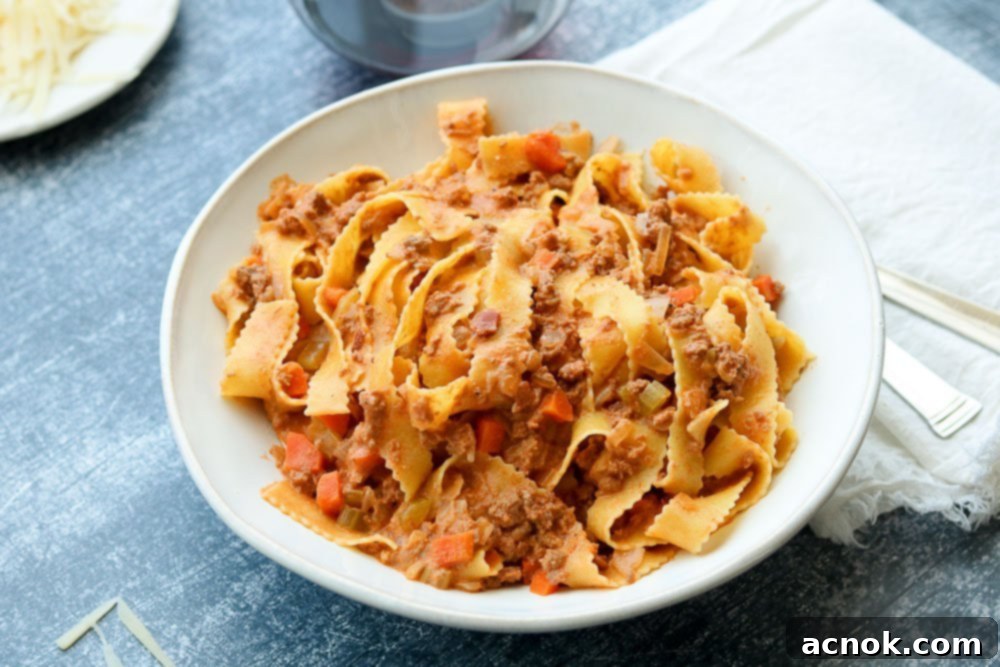Mastering the Ultimate Rich Ragù Bolognese Sauce: A Velvety Italian Classic
Prepare to embark on a culinary journey with this truly indulgent Rich Ragù Bolognese Sauce. It’s more than just a pasta topping; it’s an experience described with words like velvety, profoundly rich, wonderfully creamy, and surprisingly delicate. What sets this recipe apart is its subtle tomato flavor, allowing the deep, savory notes of the meat and aromatics to shine. This luxurious sauce finds its perfect partner in light, porous egg noodles such as Tagliatelle or Pappardelle. Their tender texture and mild flavor are exquisitely suited to absorb and complement every nuance of this super decadent sauce, creating a harmonious and unforgettable meal.
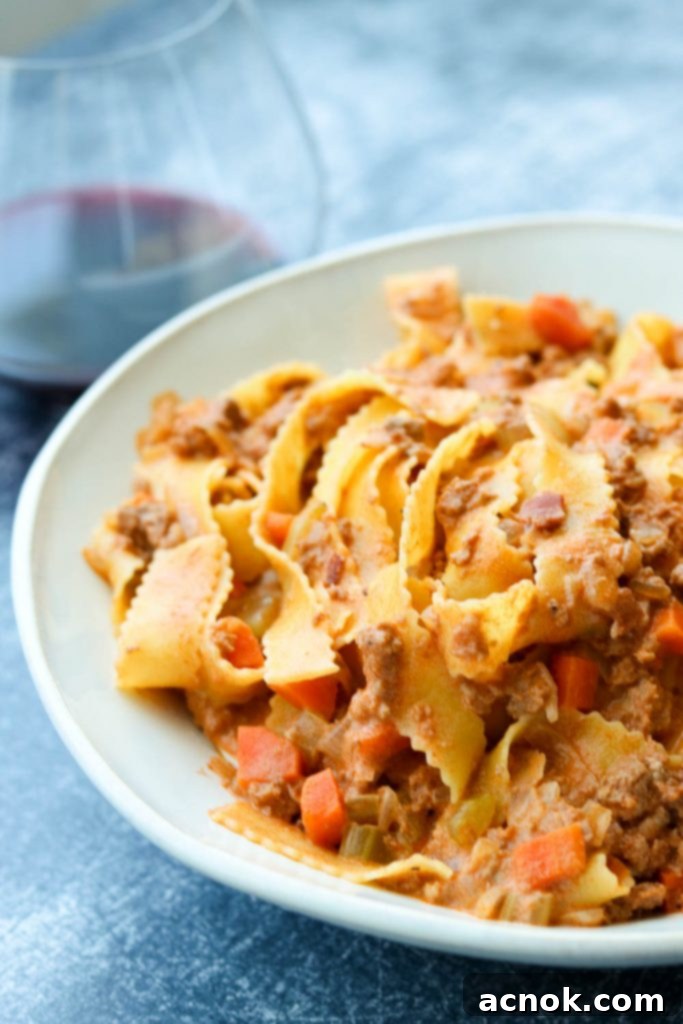
Crafting the Best Rich Ragù Bolognese Sauce: A Labor of Love
This Rich Ragù Bolognese Sauce is not an everyday meal; it’s a cherished recipe reserved for moments that truly deserve a celebration – be it a special occasion or the joy of hosting cherished company. In our household, it’s a dish that signifies warmth, generosity, and a treat for the senses. Over two decades, this recipe has been perfected, shared, and adored by friends who often leave with a double batch to enjoy later. Very little has changed in its essence, a testament to its timeless appeal, though an occasional bay leaf might be added on a whim for an extra layer of subtle aroma. Beyond that, the fundamental techniques and ingredients remain constant, ensuring a consistently spectacular result.
Let’s delve into the heart of this amazing Rich Ragù Bolognese Sauce and unlock its secrets.
The Foundation: Quality Ingredients Are Key
The ingredient list for this Bolognese is thoughtfully curated, focusing on consistency and quality rather than length. Each component plays a vital role in building the sauce’s complex flavor profile:
- **Carrots, Celery, Onion (The Soffritto):** These three form the aromatic base, often referred to as a “soffritto” in Italian cooking. Finely chopped, they slowly sweeten and caramelize, laying the groundwork for all subsequent flavors.
- **Pancetta:** This cured Italian pork belly is crucial for rendering rich, savory fat and adding a depth of umami. Its distinctive flavor is irreplaceable.
- **Ground Beef and Pork:** A blend of both meats provides a balanced texture and a richer, more nuanced flavor than using just one. The fat content contributes significantly to the sauce’s mouthfeel.
- **White Wine:** Used to deglaze the pan, it adds acidity and cuts through the richness, while also scraping up flavorful bits from the bottom.
- **Chicken Broth:** This liquid aids in the slow cooking process, keeping the meat moist and tender while infusing the sauce with flavor.
- **Tomato Paste:** Unlike a tomato-heavy pasta sauce, Bolognese uses tomato paste for a concentrated, subtle tomato essence rather than an overpowering burst of acidity.
- **Heavy Cream:** The luxurious finishing touch, it transforms the sauce into its signature velvety and creamy consistency.
- **Salt and Pepper:** Essential seasonings to bring out and balance all the flavors.
Selecting and Preparing Your Pancetta
For the best results, I highly recommend sourcing the fattiest pancetta you can find. I often visit the deli section of my local grocery store and ask for it to be sliced thickly. This ensures maximum fat rendering, which is essential for creating the rich base of the sauce. If pancetta proves elusive, a good quality, thick-cut bacon can serve as a suitable, albeit slightly different, alternative. Chop your pancetta into small, uniform pieces to ensure even rendering.
Begin by frying the chopped pancetta over medium heat in a sturdy Dutch oven. This slow rendering process is where the magic begins. If your pancetta is on the leaner side, don’t hesitate to add a splash of olive oil to help it along. You want the fat to melt out slowly, leaving behind crispy, flavorful bits.
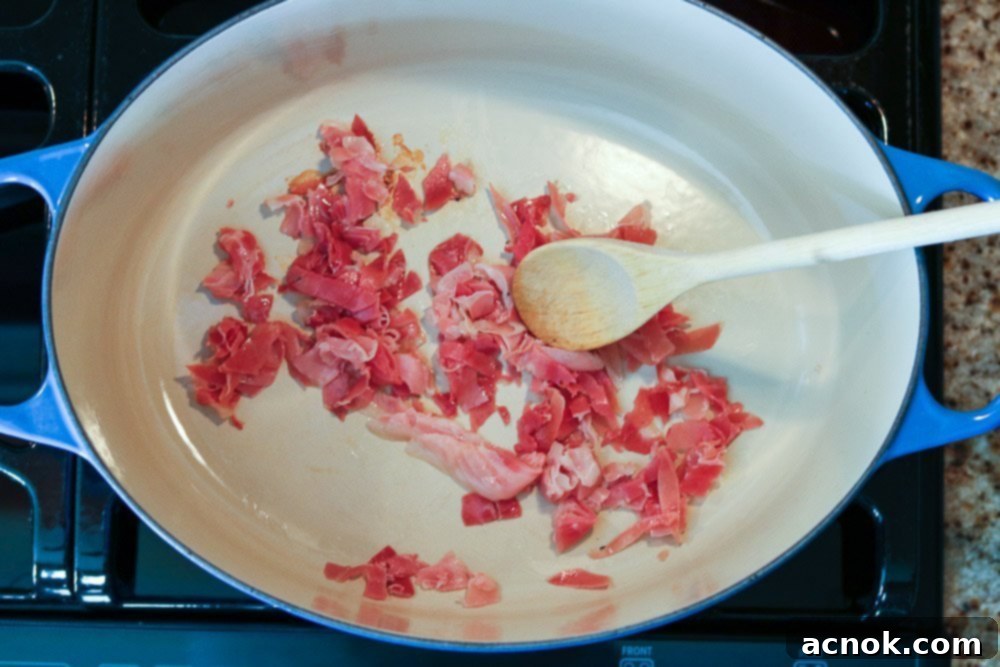
Building the Flavor Base: Soffritto and Meats
Once all the delicious fat has rendered from the pancetta, carefully remove the crispy bits – save them for a garnish or a chef’s snack! In the remaining flavorful fat, add your finely chopped carrots, celery, and onion. This trio, known as a soffritto, is the aromatic soul of the sauce. Sauté these vegetables gently for about 5-10 minutes, allowing them to soften and release their natural sweetness. It might seem like a substantial amount of chopped vegetables, but trust the process; they will cook down considerably and perfectly balance the richness of the meat.
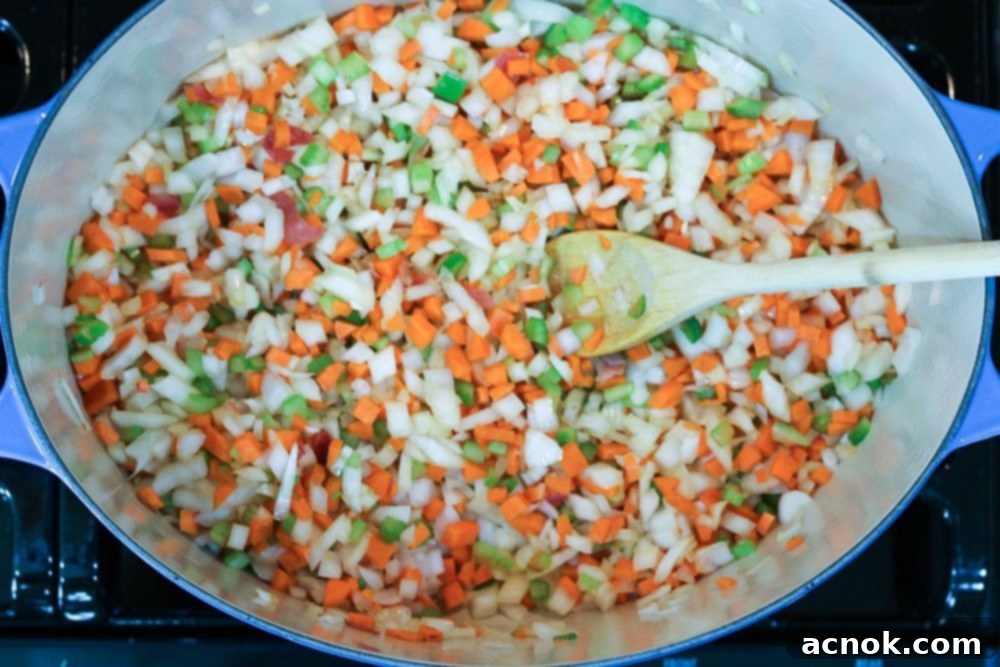
Next, it’s time to introduce the ground beef and pork. Break up the meat as it cooks, ensuring it browns evenly. Once the meat is nicely browned, pour in the white wine, allowing it to deglaze the pan. Scrape up any flavorful browned bits from the bottom of the Dutch oven – these add incredible depth to your sauce. Then, stir in the chicken broth, tomato paste, salt, and pepper. Bring the mixture to a gentle simmer.
The Slow Simmer: Developing Deep Flavors
Now, the most crucial step for any authentic Bolognese: the slow simmer. Let the sauce gently cook for at least 45 minutes, or ideally, much longer (up to 2-3 hours for maximum flavor development). During this time, the flavors will meld and deepen beautifully. Check the mixture often to ensure it’s not sticking to the bottom, stirring occasionally. Also, use your spoon to break down any larger pieces of ground meat, aiming for a fine, uniform texture that’s characteristic of a traditional ragù. If the sauce begins to stick, add chicken broth, 1/4 cup at a time, just enough to prevent sticking and maintain a loose consistency. This gradual addition ensures you don’t thin out the sauce too much.
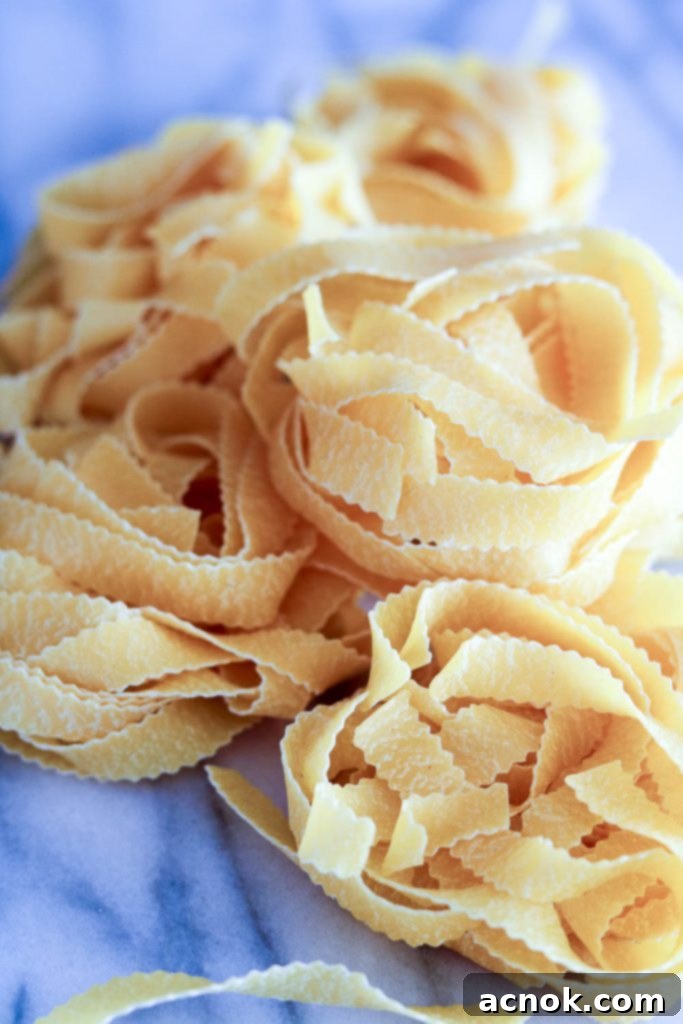
The Velvety Finish
After your initial 45 minutes (or extended simmering), taste the sauce and adjust the salt and pepper as needed. This is your chance to fine-tune the seasoning to perfection. Finally, and this is where the sauce truly becomes “velvety,” add the heavy cream. Stir it in thoroughly until it’s fully incorporated, then cook for just about 2 more minutes, allowing the cream to warm through and bind with the other ingredients, creating that signature rich and smooth texture.
The Perfect Pasta Pairing for Your Rich Ragù
When it comes to serving a rich, thick sauce like Bolognese, the choice of pasta is paramount. The best pasta to serve with this Ragù is unequivocally an egg noodle. Their slightly rough, porous texture and broad surface area are ideal for capturing and holding onto every luscious drop of sauce. My personal favorite is Reginelle, a beautiful wavy-edged egg pasta, which you can see pictured. This sauce recipe is perfectly portioned for 1lb of a wide egg pasta such as Pappardelle, Tagliatelle, or the exquisite Reginelle. Before serving, generously grate fresh Parmesan Reggiano over your plate to taste. Serve this gorgeous Rich Ragù Bolognese Sauce immediately and savor every exquisite bite.
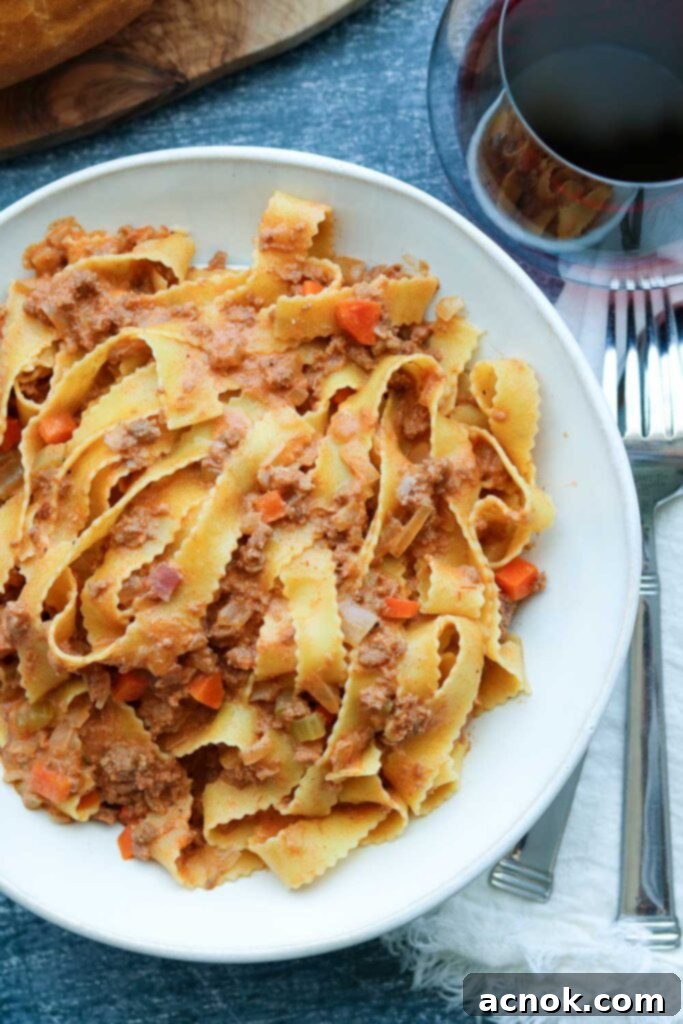
Make-Ahead & Freezing Tips for Convenience
This magnificent sauce is perfect for meal prepping! You can prepare the entire Ragù ahead of time, which often allows the flavors to deepen even further overnight. However, remember a crucial tip: only add the heavy cream at the very end of your reheat, just before you’re ready to serve. This prevents the cream from separating or becoming grainy during storage and ensures that silky finish. Furthermore, this sauce freezes exceptionally well. Simply portion it into freezer-safe containers once cooled, and it will be ready for a delicious meal on a busy weeknight. Simply thaw, reheat, stir in the cream, and enjoy!
For another fantastic and freezer-friendly option, be sure to check out our Quick and Easy Weeknight Pasta Sauce – a true marvel for effortless dining.
All content and photographs ©Claudia’s Table and claudiastable.com
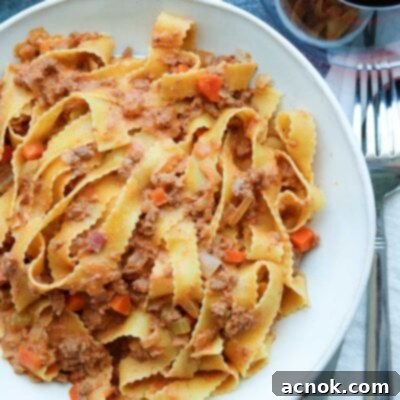
Rich Ragù Bolognese Sauce
Ana | Claudia’s Table
October 19, 2020
Pin Recipe
Equipment
-
Dutch Oven (heavy-bottomed pot)
-
Large pot for cooking pasta
Ingredients
- 3 medium carrots peeled and finely chopped
- 2 large celery stalks finely chopped
- 1 large onion finely chopped
- 3 oz pancetta or thick-cut bacon chopped into small pieces
- 1 lb ground beef
- 1/2 lb ground pork
- 1/2 cup dry white wine
- 1/2-3/4 cup chicken broth reserve extra in case you need it during simmering
- 1 6 oz can tomato paste
- 1 tsp kosher salt
- 1/2 tsp black pepper
- 1 cup heavy cream at room temperature
- Olive oil (if needed for lean pancetta)
- Freshly grated Parmesan Reggiano for serving
- 1 lb egg pasta (Pappardelle, Tagliatelle, or Reginelle)
Instructions
-
In a large Dutch oven or heavy-bottomed pot, fry the finely chopped pancetta over medium heat. Render the fat slowly until the pancetta is crispy. If using lean pancetta, add a tablespoon of olive oil to assist.
-
Once the fat is fully rendered, remove the crispy pancetta bits from the pot and set aside.
-
Add the finely chopped carrots, celery, and onion to the same pot with the rendered fat. Sauté for approximately 5-10 minutes, until the vegetables soften and become fragrant.
-
Add the ground beef and ground pork to the vegetables. Cook, breaking up the meat with a spoon, until it’s evenly browned. Pour in the dry white wine and deglaze the bottom of the pot, scraping up any browned bits. Stir in the chicken broth, tomato paste, kosher salt, and black pepper. Bring the mixture to a gentle simmer.
-
Reduce the heat to low, cover partially, and simmer for at least 45 minutes, or up to 2-3 hours for deeper flavor. Stir occasionally and check to ensure the sauce isn’t sticking. If it starts to thicken too much or stick, add 1/4 cup of reserved chicken broth at a time until it reaches the desired consistency. Continue breaking up any large meat clumps.
-
After simmering, taste the sauce and adjust salt and pepper if necessary. Stir in the room temperature heavy cream and cook for an additional 2 minutes, until thoroughly combined and heated through.
-
Serve the sauce immediately over 1 lb of cooked egg pasta (Pappardelle, Tagliatelle, or Reginelle). Garnish with freshly grated Parmesan Reggiano and the reserved crispy pancetta bits, if desired.
-
**Make-Ahead & Freezing:** This sauce can be made ahead of time. Store the sauce (without cream) in the refrigerator for up to 3 days or freeze for up to 3 months. When reheating, add the heavy cream at the very end, just before serving, for the best velvety texture.
Notes
Nutrition
Nutritional information is calculated online and should be used as a guide.
All content and photographs ©Claudia’s Table and claudiastable.com
All content and photographs ©Claudia’s Table and claudiastable.com
Check out our New & Delicious posts below
- Pasta with Grilled Vegetables, Feta, and Lemon
- Grilled Asian Marinated Flank Steak
- Classic Homemade Chunky Blue Cheese Dressing
- 3-Ingredient Crispy Oven-Roasted Potatoes
- Grilled Peach Avocado Chicken Salad
